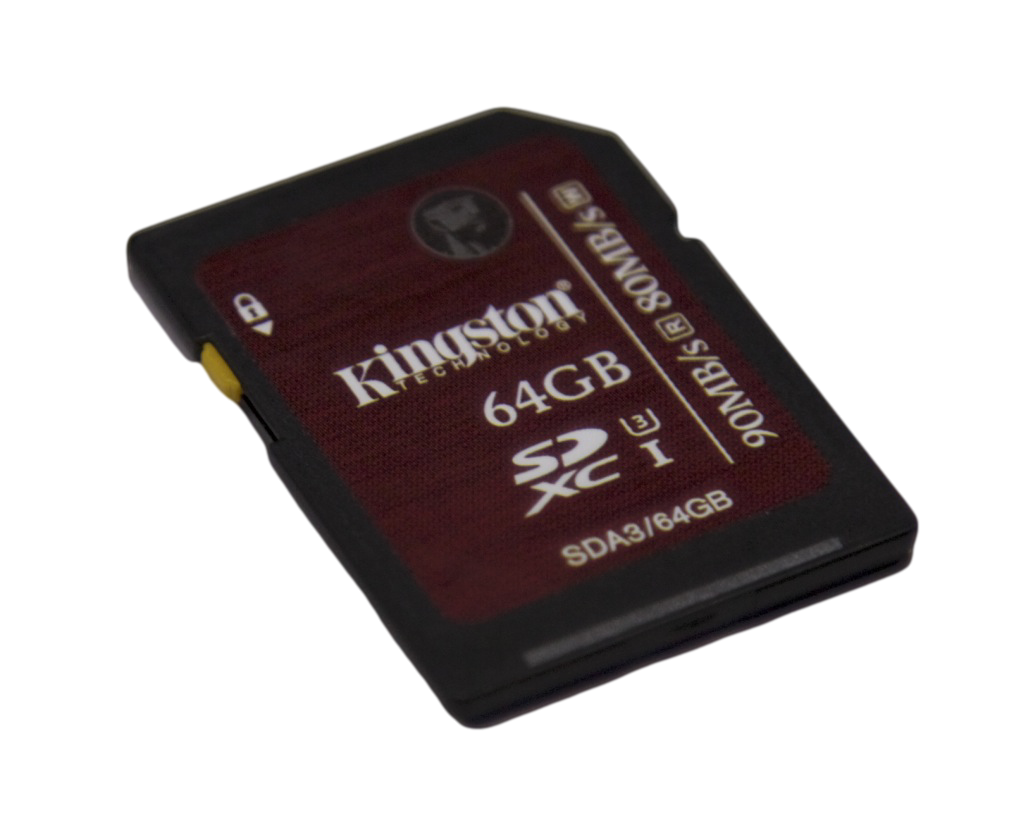Each day in the technology field there is a new advancement or improvement, whether that be faster solid state drive’s, televisions with increased visual quality, or cameras that take pictures in extreme detail. However, with these improvements it is common to find a subfield that slows down the process, such in the case of videography and it’s storage. As the demand for higher resolution video content increase (I.e., 4K television), so does the demand for storage options that can handle the content. The dilemma here lies when a videographer is filming a video in a high-resolution, the content not only requires larger than normal storage capacities, but also the transfer speed must be able to accompany the content. No one wants to waste their valuable time watching as Windows transfers the video file in slow motion.
To help with this dilemma, Kingston Technologies has produced a flash card that supports the latest in flash card performance specifications. Introducing, the Kingston SDXC UHS-1 Speed Class 3 Flash Card, designed with 3D, 4K, and 2K video content in mind. Let’s dig in deeper and see how the SDXC card stands up to our testing situations.
FEATURES AND SPECIFICATIONS
To start off, let us break down the hieroglyphics that follow the Kingston brand (I.e., SDXC UHS-1 Speed Class 3). There are a few acronyms and short forms that some may not know, some of you may, so let’s run through it quickly to keep everyone on the same page.
What does SDXC mean? When considering the size necessary for your photography or videography, your storage device will be your ultimate determinant. Obviously a flash card with a lower capacity will hold less videos and photos, which is pretty straight forward. If you have an SD (Secure Digital) card, you are probably going to want to upgrade that shortly, as that is an older technology that accompanied the first digital photography and videography devices. With it you will find not only lower capacities, but slower transfer speeds. To go the next step up to a more prevalent storage option, especially for photography enthusiasts and weekend photo shoots, is SDHC (Secure Digital High Capacity). SDHC cards can allow for capacities of up to 32GB, and transfer speeds of up to 42 MB/s. If you are looking to shoot video in a higher resolution, then you will find yourself looking one step further with SDXC (Secure Digital Xtended Capacity). SDXC can allow for capacities greater than 32GB, and have a maximum write speed of up to 95 MB/s.
If you are interested more in videography, than the next acronym is your key point to look for, especially if you are worried about transfer speeds. If you have a flash card handy, take a look at it, you may notice that there is a number that has a circle around it. This is your class rating, which denotes the guaranteed minimum write speed. To give you an example if you have a ‘4’ within your circle, your flash card is guaranteed to write at a minimum of 4 MB/s. When you start to get up to higher minimum write speeds, you will notice that the number will not increase past ’10’, instead the denotation changes to UHS-1, or a U with a ‘1’ or a ‘3’ within it. ‘Ultra High Speed 1’ would guarantee minimum write speeds of 10 MB/s and UHS-1 Speed Class 3 would denote minimum speeds of 30 MB/s. If your DSLR or video camera is not capable of UHS-1, than the flash card will revert back to Class 10 performance.
Alright, back to the Kingston SDXC flash card. The flash card can be acquired in capacities of 16, 32, and 64GB, with the pricing from $37.83, to $57.19, and finally $105.99. All capacities are accompanied by Kingston’s lifetime warranty.
Kingston has listed that the SDXC flash card will have read speeds of up to 90 MB/s and write speeds of up to 80 MB/s, as well as that these speeds are best seen when using a USB 3.0 card reader. With our test bench we utilized the Kingston MobileLite G3 USB 3.0 Card Reader. This is a simple plug-and-play device that you will connect into your USB 3.0 port on your system, and insert your flash card to transfer content.
Additionally, the Kingston MobileLite G3 USB 3.0 Card Reader is backwards compatible to USB 2.0. This means that if your USB port on your computer is not blue in colour, then you can still use the drive. You will just receive that annoying notification from Windows letting you know that the drive can perform faster in a USB 3.0 port. If your computer is not equipped with the latest USB technology, then we encourage you to have a look at our report of the HighPoint 4-Port HBA. This PCIe expansion card easily allows you to add four additional USB ports to your system, as well as the addition of USB 3.0 technology.
 The SSD Review The Worlds Dedicated SSD Education and Review Resource |
The SSD Review The Worlds Dedicated SSD Education and Review Resource | 


Nice review Chris ^^
Wow, these 4K speeds are really depressing. Although it’s expected, since sequential workload is most expected on these kinds of cards anyway..
I hate SD cards of any kind. Use one of those Thunderbolt portable drives that consist of two SSD in RAID 0. No more speed problems, and you’ll get tons more storage, too.
SD card lover when you consider that they are a necessity in photography. The fact that I have a 256GB SD card in my EOS 6D is as comforting as the fact that it’s performance (compared to that of only a short time ago) results in visible upgrade in HDR backlit shots where 3 shots are taken and combined.